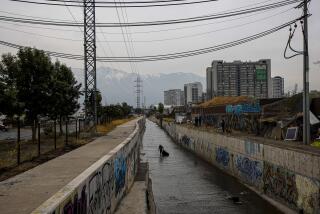Scavengers Are Gauge of Rising Poverty
- Share via
JOSE LEON SUAREZ, Argentina — Most people avert their eyes when the Ghost Train rattles past. Probably they wish they hadn’t seen it. Or maybe they want to believe it doesn’t exist. After all, it has no official timetable, no windowpanes, no doors in the frames and no seats.
But the train is undeniably there. Its passengers are trash scavengers who travel every day from this down-on-its-luck northwestern suburb to a city still known, occasionally, as “the Paris of Latin America.” These “cardboard people” of Buenos Aires are perhaps the most potent symbol of the sudden increase in poverty across the region, a trend documented this month by a U.N. report.
In 2001, 214 million people, or about 43% of Latin Americans, were living in poverty, according to the study by the Economic Commission for Latin America and the Caribbean. The study estimates that by the end of this year, there will be 15 million more Latin Americans living in poverty than in 2000.
Roughly one-fourth of the new poor are Argentines, with increases too in those countries that have traditionally sent migrants to work in Argentina, including Bolivia, Brazil, Peru, Paraguay and Uruguay.
“Argentina weighs heavy in the total increase we’ve seen in poverty in the region these last few years,” said Jose Antonio Ocampo, executive secretary of the commission. “We expect the largest increase in the following year to also be in Argentina.”
In Buenos Aires, the cardboard people began appearing in large numbers during the two-year period covered by the report and have become a fixture of life. Their numbers have tripled in the last year and, by some estimates, have reached 50,000.
The city has given commuting cartoneros, as they are known in Spanish, a train of their own so they don’t bother “respectable” passengers with their carts of scrap paper, cardboard, cans and salvaged food. Since late 2000, the Ghost Train has left every afternoon from the ramshackle station at Jose Leon Suarez with 300 men and women who make a living harvesting scraps from trash bins.
“This is our job now. This is how we survive,” said Lidia Quinteros, a former shoe factory worker who has become a leader of the trash collectors on the Ghost Train. “The company laid everyone off. They put us on the street.” Now the street provides her family a living of sorts.
“A quarter of them are traditional scavengers,” Vicente Muleiro, a poet and journalist, wrote in October. “The rest are ex-waiters, ex-factory workers, ex-maids, ex-something from the 1990s, who step into the 21st century with scavengers’ shoes, worn-out Reeboks.”
Official unemployment in Argentina is 18%. But the country is only the most extreme case marking the end of a chapter in recent Latin American history.
For much of the 1990s, governments from Brazil to Mexico embraced neoliberal economics, opening their countries to outside investment and free trade. Those reforms helped feed a boom in the Latin American economy. By 1997, the poverty rate in the region had dropped almost 5 percentage points compared with 1990, according to the commission’s study.
Now that boom has lost its steam.
“Since then the region has seen economic growth and the fight against poverty stagnate and, in some cases, clearly retreat,” Ocampo wrote in his report. “It is no exaggeration ... to say that the population of Latin America has been affected by the negative consequences of this lost half-decade.”
The report forecasts an economic contraction of 0.8% in the region this year. Some countries have managed to hold on to the gains of the 1990s, however. In Mexico and the Dominican Republic, poverty rates have dropped slightly in recent years.
But a slowing economy in most nations, and a deepening recession in others, mean that “it will be virtually impossible” for many Latin American countries to halve extreme poverty by 2015, the goal set in the September 2000 United Nations Millennium Declaration.
In Bolivia, one of Latin America’s poorest nations, poverty crept up in 2001, reaching 61%. Recent years have seen thousands of impoverished migrants abandon the countryside for areas such as the La Paz suburb of El Alto, one of Bolivia’s fastest-growing cities.
“It’s difficult for a country like Bolivia to get out of poverty, but it is easy to fall back in,” said Gonzalo Chavez, a La Paz economist. “The gains made over a decade of growth have been lost in the last three years.”
The share of people living in extreme poverty, or indigence, in Bolivia remains higher -- 37.3% -- than the overall poverty rate in Argentina of 30.3%, according to the U.N. study.
“In Bolivia, there is no safety net when the economy goes into crisis,” Chavez said. “Our poor are very vulnerable. Overnight, they can lose their homes and end up sleeping on the street.”
Traditionally, many have fled to Argentina. Half a century ago, Jose Leon Suarez was a mecca for the hundreds of thousands of Italian immigrants arriving in Argentina in the wake of World War II. Now impoverished Bolivians and Peruvians live among the struggling Argentines.
The train company added the Ghost Train -- also called the White Train -- two years ago, in response to the growing number of scrap collectors on its routes. The cartoneros pay a monthly fare of about $5. Jorge Molina, a spokesman for the company, said the riders practically dismantled the first Ghost Train.
“It had aluminum parts, windows and locks, all of which were valuable to the cartoneros,” he said. “The train they have now is adapted to their needs. It’s stripped down.”
The old white cars clearly make up relics from another era, a bare metal shell of a train that looks conspicuously out of place as it chugs past middle-class Buenos Aires.
Most of the cartoneros on the line have invested a bit of their earnings in specialized carts. For about $35, welders attach car wheels to a steel frame, creating a contraption that allows one person to push up to 500 pounds of scrap down the street.
“This train is something we fought for, so that we could work in peace,” said Norma Flores, a cartonera and mother of five who leads a neighborhood committee of scavengers.
At the end of the day, just before midnight, she rolls her cart up the ramp to the station in the middle-class community of Belgrano. After a week of trudging around the city, gathering paper and cardboard mostly, she usually makes about $30.
*
Times researcher Andres D’Alessandro in Buenos Aires and Times special correspondent Andrew Enever in La Paz contributed to this report.
More to Read
Sign up for Essential California
The most important California stories and recommendations in your inbox every morning.
You may occasionally receive promotional content from the Los Angeles Times.














